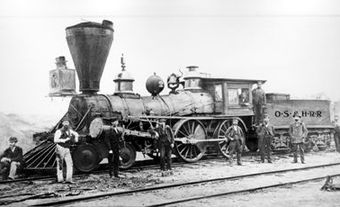Great Western Railway
The London and Gore Railroad Co, incorporated 6 May 1834, changed its name to the Great Western Rail Road Co in 1845 and to the Great Western Railway in 1853. Promoted by lawyer-politician Allan Napier MACNAB and more significantly by Hamilton merchants Isaac and Peter Buchanan, R.W. Harris and John Young, and aided by government guarantees, the railway attracted sufficient American and British capital to open its main line (Niagara Falls-Hamilton-London-Windsor) in Jan 1854. By 1882 it operated 1280 km of track throughout SW Ontario and 288 km in Michigan.
Under Charles John Brydges's aggressive management, the railway enjoyed initial financial success, but following the depression of 1857 it suffered as a result of careless construction, rapid expansion, increased local competition and protracted internal managerial conflict. While the railway helped to stimulate and integrate the local economy, it also relied for 40-60% of its gross revenue on through American traffic between New York and Michigan states. As American competitors consolidated lines, through rates fell and the Great Western and its chief local rival, the GRAND TRUNK RAILWAY, suffered. In 1882, after decades of disastrous competition, the 2 railways merged forces in order to compete more effectively with rival American railroads.

 Share on Facebook
Share on Facebook Share on X
Share on X Share by Email
Share by Email Share on Google Classroom
Share on Google Classroom





